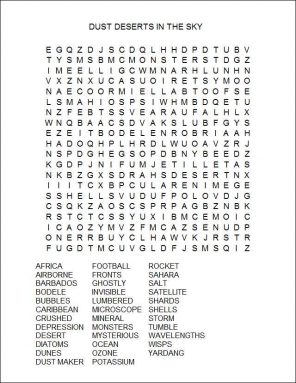Dust creates deserts in the sky
Scientists visit a desolate, deserted battlefield to discover the dustiest place on Earth
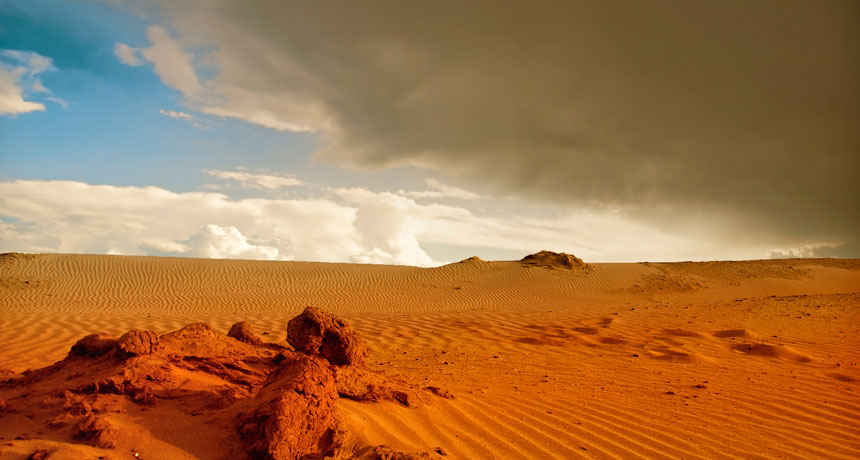
Deserts can produce dust that travels far, far away, even across oceans.
venturecx/istockphoto
By Douglas Fox
The first of two parts on the impacts of intercontinental plumes of dust.
A line of four trucks meandered left and right as they steered around sand dunes in a remote part of North Africa. Their engines whined as they lumbered forward in low gear. Their wheels juddered over rocks, bouncing the passengers in their seats.
Richard Washington and several companions had traveled from England in early 2005 to explore this place in the vast desert called the Sahara. They had left the last city three days earlier, carrying 200 liters (more than 50 gallons) of extra gasoline. They were on their way to see the dustiest place on Earth.
To them, it was just a mysterious spot on the map. Washington is an atmospheric scientist at Oxford University in England. He and his companions had pinpointed this place only a few months earlier. They used pictures from satellites orbiting Earth. Soon, they would finally see it for real.
Dust is a powerful, but invisible, force. It shapes Earth’s environment in ways that few people realize. Every year, three to four billion tons of dust is lifted into the air around the world by wind. That’s enough to cover the city of Chicago, Ill., to a depth of 5 meters (16 feet).
Once airborne, this dust can travel thousands of kilometers. It nourishes some of our planet’s largest and lushest forests — allowing them to grow where otherwise they could not. It triggers rain and snowfall. It may even ferry diseases across oceans.
This is the first of two stories on dust. It tells how scientists accidentally uncovered the amazing travels of dust around the world. Next week, we will see how dust shapes Earth’s environment.
Lone tree
Washington’s planned destination in that 2005 trip was an area where few people go. Found within north-central Africa, in the country of Chad, this region has no towns, telephones or electricity. Here, on the southern edge of the Sahara — the world’s largest hot weather desert — sits the planet’s largest source of airborne dust.
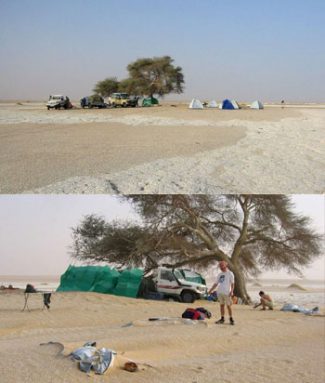
This postage stamp of land covers just one five-hundredth of the Sahara. But it spews out as much dust as all the rest of the desert combined!
Washington and his companions hoped to find out how such a tiny piece of land could possibly shed that much dust. Six other scientists plus a cook and four guides traveled with him that February 27, in their four-truck convoy.
By late in the afternoon, the group finally emerged from the dunes and arrived at the Bodélé Depression. They had expected the lake bed to be covered in a soft, wispy silt that wind can easily churn up into dust. In fact, they found nothing of the sort.
Their trucks left no tracks as they rolled over a flat plain of hard, chalky-white stone. “That was actually quite surprising,” recalls Sebastian Engelstaedter, who traveled with Washington on that trip. “We had no idea what to expect.” Engelstaedter is a desert geologist, also from Oxford. He, Washington and the others would spend the next few days figuring out how this strange place somehow turned hard stone into fine dust.
They stopped at a place called Chicha. It was marked by a single thorny acacia (Ah-KAY-sha) — the only tree for dozens of miles. They camped there for two weeks. Automatic weather stations that they set up measured temperature, wind speed and air moisture. The researchers launched balloons into the air several times a day. They tracked how each drifted as it rose to measure the winds hundreds of meters above.
Much of the time, the air at Chicha held little dust. But none of the team members will ever forget a storm that arrived later that trip. They had seen these storms play out silently, in slow motion, on satellite pictures. They knew the storms could be monsters. But nothing prepared them for the real thing.
Cosmic dust
Washington’s trip to Africa in 2005 was all about learning where dust comes from and how it gets into the air. Scientists have been trying to figure this out for half a century, ever since someone accidentally discovered how far dust can travel. That was in August 1965.
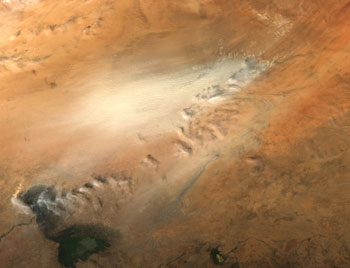
The English scientists planned to catch this “cosmic dust” in a fine net. They put the net on a tower at the eastern edge of Barbados. High on a cliff, this tower overlooked the ocean. Air blowing in had just traveled 4,500 kilometers (2,800 miles) across the Atlantic Ocean. It would be clean air, not mixed with regular Earthly dust. That would let the scientists pick out the tiny amounts of cosmic dust that came from space. Or that’s what they had thought.
They soon learned differently. The nets turned brick red within hours. “You literally get mud” in them because they collected dust so quickly, says Joseph Prospero. At the time, he was a young scientist in Florida who had learned about this soon after it happened.
With so much dust, it couldn’t be coming from space. The dust must have started from some place on Earth. So the English scientists gave up on collecting cosmic dust. They also gave up on the tower and offered it to Prospero. And he was thrilled. This was exactly the kind of dirty air he had been hoping for.
Treasure and trash
Prospero was an atmospheric chemist who had just started his first job at the University of Miami in Florida. He never planned to study dust. He found himself working on it by accident.
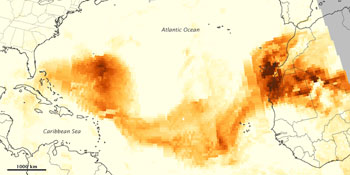
But Prospero discovered the elements didn’t come from salt. He had built a little machine that made bubbles. He took it on a research ship thousands of kilometers from land. He floated his machine on the ocean and measured what elements were flung into the air by the bursting bubbles. The mix of elements coming from the bubbles did not match what other scientists were measuring in the air above the remote oceans. In other words, the stuff scientists were finding in the air clearly wasn’t sea salt.
Prospero also was finding other clues that helped him make sense of his data. Among them was mud that other scientists had collected during research cruises. The mud was from the bottom of the ocean, often from a depth of more than 3,000 meters (about 10,000 feet). Some samples had come from parts of the ocean that were thousands of kilometers from land. They were all cluttered with tiny flecks of crystals — minerals known as quartz and mica (MY-kah). These minerals were known to form on land, not in the sea.
Perhaps, Prospero thought, the minerals on the sea floor and the sodium, potassium and calcium in the air above the water were coming from the same source: tiny grains of dust. That dust might ride the winds for thousands of kilometers before finally settling down onto the ocean. If true, it would mean that 30 to 80 percent of the mud on the sea floor actually came from distant lands!
The tower in Barbados finally let Prospero tie these threads of evidence together. It confirmed his suspicions. In 1968, he reported that the red mud collected in Barbados contained the same mineral recipe that other scientists had found in soils from the Sahara. “That was the beginning of the African dust story,” Prospero recalls.
The following year, he spent 300 hours on an airplane as it made dozens of research flights over the Atlantic. Those flights crisscrossed a region of the ocean between Barbados and Africa. Prospero collected dust the entire way. Those flights revealed something never seen before: One to three kilometers (0.6 to 1.9 miles) up in the sky, there was a moving conveyor belt of hot, dry air. That air periodically got hazy as the plane passed through. “You could see that there were dust fronts coming through,” Prospero recalls. That conveyor belt of dusty air stretched from Africa across the ocean, to the Caribbean. It is now known as the Saharan Air Layer.
View from above
Fifty years ago, says Prospero, “people were not thinking in terms of long-range transport” of dust. But in 1972, he published calculations showing that around 30 billion kilograms (33 million tons) of Saharan dust flew over the Atlantic Ocean toward Barbados each year.
Prospero couldn’t get a complete picture of how the dust traveled from Africa to the Americas. He spent many years operating up to 30 dust-collecting stations around the world. But they provided only a spotty view of the process.
Then, in 1997, NASA scientists from the Goddard Space Flight Center in Greenbelt, Md., discovered a way to track airborne dust using pictures from satellites. The key was a satellite with a name that sounds like a magic broom in the Harry Potter novels: “Nimbus-7.”
Nimbus-7 was launched into orbit around Earth in 1978. It was supposed to measure a kind of air pollution in the lower atmosphere known as ozone. It did this by shining different wavelengths of ultraviolet light down at Earth and measuring how much got reflected back into space. But dust also absorbs some ultraviolet light. The NASA team figured out that by identifying which ultraviolet wavelengths weren’t making it back up to the satellite, they would know how much dust was filtering that light. And the satellite cameras could read that “missing” light as a faint fingerprint of dust.
Now, scientists could watch dust plumes sail through the skies even when clouds were in the way. And for the first time ever, they could pinpoint where much of that dust came from.
Savage visitor
The Bodélé Depression was first identified as the world’s biggest dust-maker in the early 2000s. The site was mysterious, remote and unstudied. So in February 2005, Washington and his companions traveled there to have a look. It was just as the region’s winter dust season was starting.
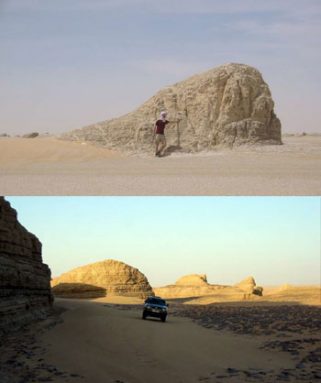
One day Washington and several companions drove up to the northern edge of the Bodélé. There, they discovered something breathtaking — and a little alarming.
Ridges of smooth, wind-battered stone stood here and there in the flat wasteland. The ridges all ran in the same direction, as though hunkered against the wind that constantly blew from the east. They towered high over their vehicle, up to 4 meters (13 feet) in the air. They showed that the bed of the lake had once been at least this high. But something had blasted away all of the stone between them.
Even hard stone can be as soft as flesh when attacked, endlessly, by the forces of nature. In this spot, it looked as if a savage giant had lashed into the earth’s bare back with a whip. It made one cut after another, until only a few islands of its skin remained — these lone, remnant ridges of rock. The wind-carved ridges are called yardangs. They revealed that the wind must truly scream through this place from time to time.
The winds had been surprisingly mild for most of the trip. But on March 10, the angry giant returned. Hour after hour, the blowing sand stung like needles. That night, the campers flattened their tents and buried them under rocks and crates to keep them from being blown away by the wind. They took refuge inside their trucks.
The wind finally eased a bit on the third day. Washington and several others drove downwind to watch the storm. The surface of the lake bed was alive with motion. Wind had pried off flat tiles of rock. These brittle shards bounced and cartwheeled like tumbleweeds. They gradually disintegrated during their 80-kilometer (50-mile) journey across the lakebed. By the far end, all that remained were ghostly wisps of dust. These slithered up steep dunes and billowed into the sky.
When Washington returned to England a few days later, he would learn that this was only a small storm by Bodélé standards. Satellite pictures showed that most other storms in the previous 10 years had been bigger. But it still helped him understand how this place makes so much dust.
The Bodélé owes its dust-making ability, in part, to a narrow saddle between two mountain ranges on its east side. Winter trade winds are funneled through this narrow bottleneck. There, the winds are boosted in speed by up by 40 percent as they rush downhill onto the lake bed.
Light and fluffy
Washington’s team took some of the rock home and made pictures of it using an electron microscope. Magnified 1,800 times, the stone appeared to be made of millions of broken glass shards, all jumbled and glued together. Some of the less-broken ones were shaped as tubes, lined along their sides with delicate rows of holes, as if made by a master glassblower.
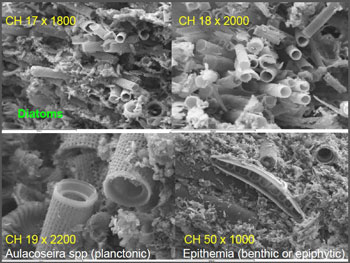
Gradually, the rock disintegrates into the tiny shell pieces that first formed it. Those pieces are smaller than a red blood cell and lightweight enough to ride the wind for thousands of kilometers without falling back to Earth. In retrospect, it makes sense that the Bodélé Depression, a huge dust-maker, is made of hard stone. “If it were light and fluffy, it would have probably been done a long time ago,” says Charlie Bristow. He is a geologist from Birkbeck College at the University of London in England, who traveled with Washington in 2005. He says that by being so hard, Bodélé’s lake bed has been able to release its dust slowly over thousands of years.
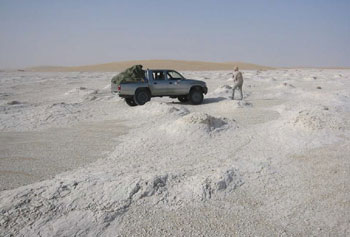
Prospero struggled for years to find government agencies that would give him money to study dust. “Look at the record of publications and you would find more on dust from Mars than you would on dust from Africa,” he says. “It’s not been until the last 15 years or so that there was any real interest.”
Scientists are finally realizing just how strongly dust shapes Earth’s landscapes, and life. Bodélé dust, in particular, has turned out to be special.
For much of the year, dust from the Sahara drifts toward the Caribbean and southeastern United States. But winds shift during the winter. Then they began carrying Bodélé dust a different way over the Atlantic Ocean. When it reaches South America, on the other side, it does something truly amazing.
Next Week: The effects of Bodélé dust on South America.
Power Words
(for more about Power Words, click here)
artillery shell A gun shell filled with explosives, which is shot from a large military gun. It can be as heavy as several bowling balls and travel for many kilometers (miles) before reaching its target.
atmosphere The envelope of gases surrounding Earth or another planet.
bedrock The thick, solid rock layer than underlies the soil and other broken, rocky materials on Earth’s surface.
calcium A chemical element which is common in minerals of the Earth’s crust and in sea salt. It is also found in bone mineral and teeth, and can play a role in the movement of certain substances into and out of cells.
Chad A land-locked nation in North Africa. It sits on the southern edge of the Sahara Desert. During the 1970s and 1980s, it fought a war with the nation of Libya, its neighbor to the north.
chemistry The field of science that deals with the composition, structure and properties of substances and how they interact with one another. Chemists use this knowledge to study unfamiliar substances, to reproduce large quantities of useful substances or to design and create new and useful substances. (about compounds) The term is used to refer to the recipe of a compound, the way it’s produced or some of its properties.
cosmic An adjective that refers to the cosmos — the universe and everything within it.
crystal A solid consisting of a symmetrical, ordered, three-dimensional arrangement of atoms or molecules. It’s the organized structure taken by most minerals. Apatite, for example, forms six-sided crystals. The mineral crystals that make up rock are usually too small to be seen with the unaided eye.
density A measure of the consistency of an object, found by dividing the mass by the volume.
diatoms Tiny, ocean- and lake-dwelling organisms made of no more than a few cells. Diatoms have shells made of silica, or glass. They live like plants, using sunlight to turn carbon dioxide into sugars.
electron microscope A microscope with high resolution and magnification that uses electrons rather than light to image an object.
environment The sum of all of the things that exist around some organism or the process and the condition those things create for that organism or process. Environment may refer to the weather and ecosystem in which some animal lives, or, perhaps, the temperature, humidity and placement of components in some electronics system or product.
fossil Any preserved remains or traces of ancient life. There are many different types of fossils: The bones and other body parts of dinosaurs are called “body fossils.” Things like footprints are called “trace fossils.” Even specimens of dinosaur poop are fossils. The process of forming fossils is called fossilization.
fronts (in Earth sciences) The boundaries that separate air masses — parcels of air having very different densities. Fronts extend both horizontally (up and down) and vertically (along a plane).
geology The study of Earth’s physical structure and substance, its history and the processes that act on it. People who work in this field are known as geologists.
glass A hard, brittle substance made from silica, a mineral found in sand. Glass usually is transparent and fairly inert (chemically nonreactive). Aquatic organisms called diatoms build their shells with it.
Libya A country in North Africa, in the northern half of the Sahara Desert. It sits on the northern border of another nation, Chad, and fought a war against Chad in the 1970s and 1980s.
intercontinental Having to do with actions or movements between continents.
mica A family of minerals, many of which readily break into small, glittering flakes.
mineral The crystal-forming substances, such as quartz, apatite, or various carbonates, that make up rock. Most rocks contain several different minerals mish-mashed together. A mineral usually is solid and stable at room temperatures and has a specific formula, or recipe (with atoms occurring in certain proportions) and a specific crystalline structure (meaning that its atoms are organized in certain regular three-dimensional patterns). (in physiology) The same chemicals that are needed by the body to make and feed tissues to maintain health.
organism Any living thing, from elephants and plants to bacteria and other types of single-celled life.
ozone A colorless gas that forms high in the atmosphere and at ground level. When it forms at Earth’s surface, ozone is a pollutant that irritates eyes and lungs.
plume (in environmental sciences) The movement of some gas or liquid, under the direction of gravity, winds or currents. It may be in air, soil or water. It gets its name from the fact that it tends to be long and relatively thin, shaped like a large feather.
potassium A chemical element that occurs as a soft, silver-colored metal, which burns on contact with air or water. It is found in ocean water, as part of sea salt, and is also found in many minerals.
quartz A type of mineral made from silicon dioxide. The most common mineral on Earth, it can occur in any rock type: igneous, metamorphic or sedimentary.
rocket Something propelled into the air or through space, sometimes as a weapon of war. A rocket usually is lofted by the release of exhaust gases as some fuel burns. (v.) Something that flings into space at high speed as if fueled by combustion.
rocket launcher A weapon used in war to shoot rockets, which explode when they hit their target.
saddle (in geology) A feature of the landscape that dips down in the center between two high summits.
Sahara The largest desert on Earth, found in North Africa. It covers an area equal to half of the United States. It produces more airborne dust than any other desert in the world.
salt A compound made by combining an acid with a base (in a reaction that also creates water). The ocean contains many different salts — collectively called “sea salt.” Common table salt is a made of sodium and chlorine.
satellite A moon orbiting a planet or a vehicle or other manufactured object that orbits some celestial body in space.
shard A piece of broken pottery, tile or rock, or anything with the irregular shape of hard, broken pieces of something.
silt Very fine mineral particles or grains present in soil. They can be made of sand or other materials. When materials of this size make up most of the particles in soil, the composite is referred to as clay. Silt is formed by the erosion of rocks, and then usually deposited elsewhere by wind, water or glaciers.
sodium A soft, silvery metallic element that will interact explosively when added to water. It is also a basic building block of table salt (a molecule of which consists of one atom of sodium and one atom of chlorine: NaCl). It is also found in sea salt.
trade winds The dominant winds, which are “easterly” (that is, they blow from east to west) in the tropical and subtropical parts of the world.
ultraviolet (UV) light A portion of the light spectrum that is close to violet but invisible to the human eye.
wavelength The distance between one peak and the next in a series of waves, or the distance between one trough and the next. Visible light — which, like all electromagnetic radiation, travels in waves — includes wavelengths between about 380 nanometers (violet) and about 740 nanometers (red). Radiation with wavelengths shorter than visible light includes gamma rays, X-rays and ultraviolet light. Longer-wavelength radiation includes infrared light, microwaves and radio waves.
yardang A rock formation carved and shaped by winds over hundreds or thousands of years. They often have a smooth, curved or streamlined shape. Mega-yardangs are such rock formations that cover vast areas, such as wind-carved grooves that can extend for many kilometers (miles).
Word Find (click here to enlarge for printing)
